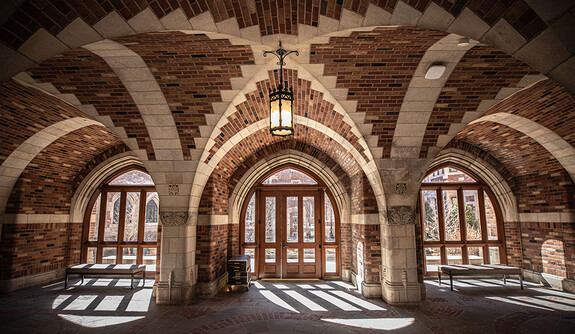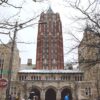
Yale News
After over 30 months of renovation, the Humanities Quadrangle — formerly known as the Hall of Graduate Studies — is completed and open to department staff, faculty and graduate students.
The quadrangle, located at 320 York St., is home to 15 departments and programs in the humanities, ranging from the American Studies Program to the Department of Spanish and Portuguese. The renovated and refurbished space was intentionally designed to allow for an intersection of private study and public collaboration. With spaces such as the Directed Studies Lounge, an Undergraduate Common Room, the Alice Cinema, and offices, meeting areas and study spaces for graduate students and postdoctoral scholars, the quadrangle aims to fortify Yale’s commitment to the humanities.
“Having a building devoted to constant intellectual exchange across the disciplines is so exciting,” said Paul Grimstad, director of undergraduate studies for the humanities major. “The humanities program is right there on the first floor as you walk in from York Street, and we’re thrilled to be at the center of the action.”
According to Yale News, the original 14-story building was designed in the collegiate Gothic style in 1932 by the architect James Gamble Rogers, who graduated from Yale in 1889. The building’s renovations increased the size of the original by expanding underground space and creating a new lower level, adding an additional 13,000 square feet to the building. At the same time, many of the building’s historical aspects — including its original wood floors and wood panels, stonework and a historic painted plaster ceiling which was part of the original 1932 building — have been restored or refurbished.
With niches, alcoves and elaborate walkways, the quadrangle hosts a dedicated collaboration space at the top level of Swensen Tower, allowing faculty and students a view of Yale’s entire campus and the surrounding New Haven area. Other new spaces include a Directed Studies Lounge, an Undergraduate Common Room, Fellows’ Hall, Grand Seminar Room, History of Science and Medicine Suite, Alice Cinema, Special Initiatives Space, Grand Meeting Room hosted by the now-relocated Whitney Humanities Center, Open Plan Workspace, and Concourse Lounge, in addition to lecture halls, classrooms, meeting rooms and a video conference room. The Quadrangle is located across the street from the Sterling Memorial Library and Poorvu Writing Center.
Kathryn Lofton, FAS dean of humanities and Lex Hixon professor of religious studies and American studies, said the building’s Gothic architecture preserves its historical aspects and statuary, reiterating “the symbolic meaning of the building” as a historic space for study of the humanities. Lofton said that the idea of close interactions between humanists is key to the neo-Gothic design of the quadrangle.
According to Katja Lindskog, director of undergraduate studies for the Directed Studies Program, there is often a misconception that work in the humanities is done “quietly, while reading big dusty books.” Even though engaging with challenging texts is a vital part of the study of the humanities, much of developing a “humanities skillset” is done by engaging in “lively, thoughtful and rigorous conversations with other people in the same physical space.”
Lindskog also acknowledged comments made by staff columnist Awuor Onguru ’24 in an April 29 column saying that the class of 2024 is likely to have a difficult transition to in-person classes this fall. Lindskog said that she shares the same concerns as Onguru and hopes that such physical spaces for “reading and gathering” will help build community for the class of 2024 and others.
In the basement of the quadrangle is the new Alice Cinema, a film screening studio. Lofton said the cinema is a testament to the role of film in Yale’s past and future, “as indicated by the stunning list of Oscar winners” who financed the screening area.
“There is no humanities without the arts; they are co-constituted,” Lofton said, citing as an example Francesco Casetti’s involvement in both areas as the incoming chair of humanities, a professor in film studies and someone highly involved in the Directed Studies Program.
Lofton said that compared to other spaces at Yale, the quadrangle is unique, as no other building includes such significant space specifically for doctoral student study and collaboration in the humanities. She hopes that the quadrangle’s occupants are inspired daily to “pursue the best answers to the toughest questions, individually and collectively.”
The building has 3,459 windows.









